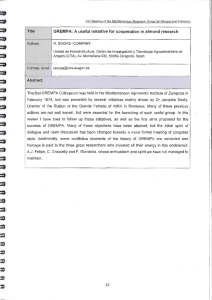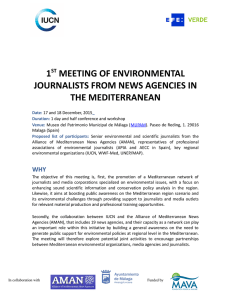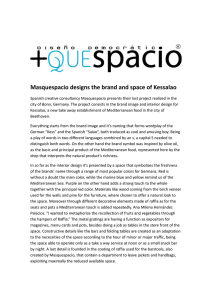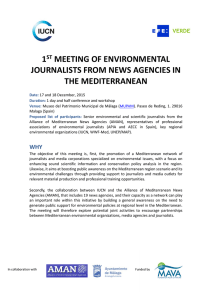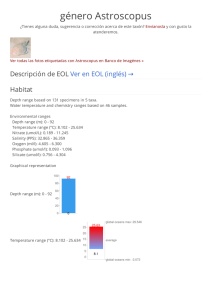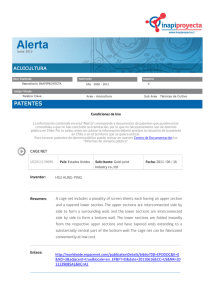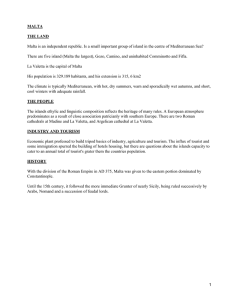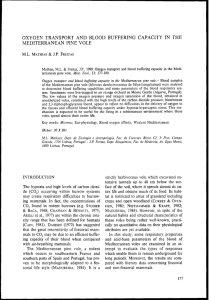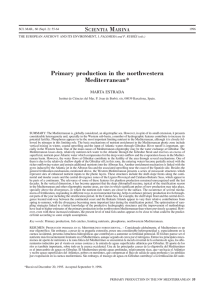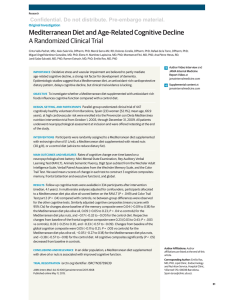Saurida undosquamis
Anuncio
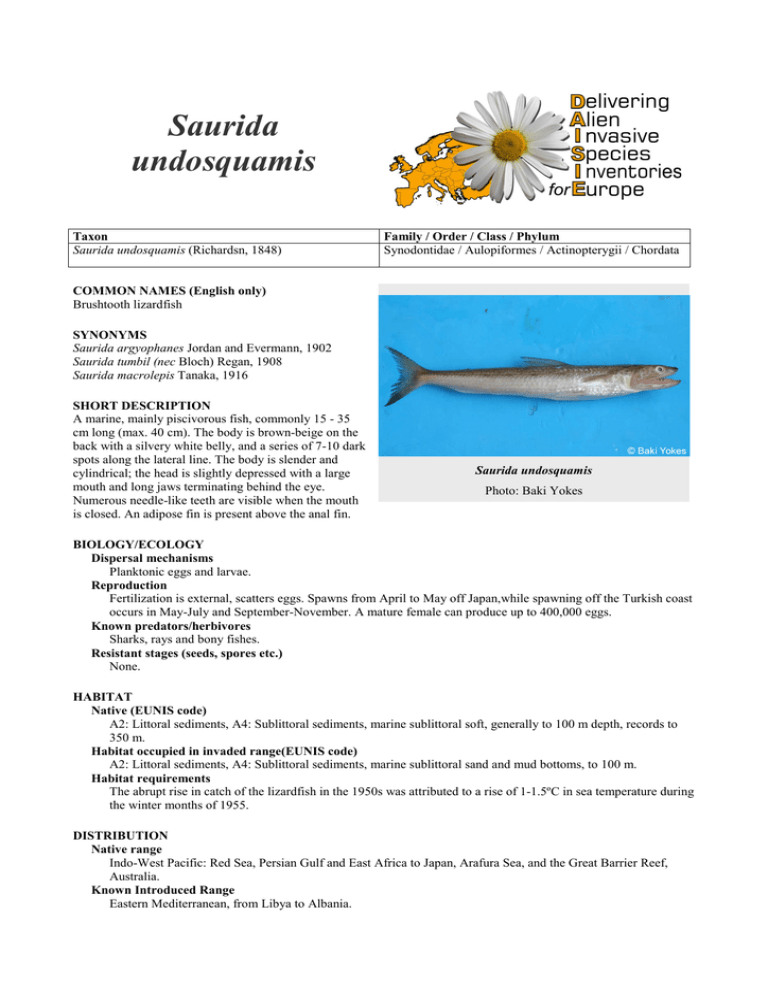
Saurida undosquamis Taxon Saurida undosquamis (Richardsn, 1848) Family / Order / Class / Phylum Synodontidae / Aulopiformes / Actinopterygii / Chordata COMMON NAMES (English only) Brushtooth lizardfish SYNONYMS Saurida argyophanes Jordan and Evermann, 1902 Saurida tumbil (nec Bloch) Regan, 1908 Saurida macrolepis Tanaka, 1916 SHORT DESCRIPTION A marine, mainly piscivorous fish, commonly 15 - 35 cm long (max. 40 cm). The body is brown-beige on the back with a silvery white belly, and a series of 7-10 dark spots along the lateral line. The body is slender and cylindrical; the head is slightly depressed with a large mouth and long jaws terminating behind the eye. Numerous needle-like teeth are visible when the mouth is closed. An adipose fin is present above the anal fin. Saurida undosquamis Photo: Baki Yokes BIOLOGY/ECOLOGY Dispersal mechanisms Planktonic eggs and larvae. Reproduction Fertilization is external, scatters eggs. Spawns from April to May off Japan,while spawning off the Turkish coast occurs in May-July and September-November. A mature female can produce up to 400,000 eggs. Known predators/herbivores Sharks, rays and bony fishes. Resistant stages (seeds, spores etc.) None. HABITAT Native (EUNIS code) A2: Littoral sediments, A4: Sublittoral sediments, marine sublittoral soft, generally to 100 m depth, records to 350 m. Habitat occupied in invaded range(EUNIS code) A2: Littoral sediments, A4: Sublittoral sediments, marine sublittoral sand and mud bottoms, to 100 m. Habitat requirements The abrupt rise in catch of the lizardfish in the 1950s was attributed to a rise of 1-1.5ºC in sea temperature during the winter months of 1955. DISTRIBUTION Native range Indo-West Pacific: Red Sea, Persian Gulf and East Africa to Japan, Arafura Sea, and the Great Barrier Reef, Australia. Known Introduced Range Eastern Mediterranean, from Libya to Albania. Trend First collected in the Mediterranean in 1952 (Israel, Turkey), then Cyprus (1960), Lebanon (1962), Egypt (1966), subsequently collected off Greece, Albania and Syria. Everywhere it formed thriving populations in an amazingly short space of time. MAP (European distribution) Known in country Legend Known in CGRS square Known in sea Key distribution area Infrequent Unestablished INTRODUCTION PATHWAY Entered the Mediterranean through the Suez Canal, and spread with the prevailing currents. IMPACT Ecosystem Impact The sudden increase of the lizardfish came at the expense of the native hake, Merluccius merluccius, which was displaced into deeper waters. Health and Social Impact Unknown. Economic Impact In 1955-56 the lizardfish became commercially important, constituting for a few years over half of the total catch on the shallow shelf opposite El-Arish, up to one fifth of the total annual trawl catch along the Mediterranean coast of Israel, and an important staple of the coastal fishery in the area stretching from Damietta eastward to Port Said. By the mid 1960s it formed the main catch of trawlers off Mersin, Turkey, and accounted for 2/3 of the fish landing biomass in the autumn months of the 1980s. Since the mid 1980s the lizardfish’s share in catches has declined. MANAGEMENT Prevention Erect a salinity barrier in the Suez Canal in order to reduce the number of Red Sea aliens arriving in the Mediterranean. Mechanical Unknown. Chemical Unknown. Biological Unknown. REFERENCES Ben-Yami M,. Glaser T (1974) The invasion of Saurida undosquamis (Richardson) into the Levant Basin - An example of biological effect of interoceanic canal. Fishery Bulletin, 72:359-373 Golani D (1993) The biology of the Red Sea migrant, Saurida undosquamis, in the Mediterranean and comparison with the indigenous confamilial Synodus saurus (Teleostei: Synodontidae). Hydrobiologia 271: 109-117 www.ciesm.org/atlas/ OTHER REFERENCES Ben-Tuvia A (1953) New Erythrean fishes from the Mediterranean coast of Israel. Nature 172:464-465 Ben Tuvia A (1966) Red Sea fishes recently found in the Mediterranean. Copeia 2:254-275 El-Sayed R S (1994) Check-list of Egyptian Mediterranean fishes. National Institute of Oceanography and Fisheries 77+IX pp., Alexandria, Egypt George C J, Athanassiou VA, Boulos I (1963) The fishes of the coastal waters of Lebanon. Miscellaneous Papers in the Natural Sciences, the American University of Beirut 2: 1-149, 1-8 Ismen A (2003) Maturity and fecundity of lizardfish Saurida undosquamis (Richardson) in Iskenderun Bay (Eastern Mediterranean). Turkish Journal of Zoology 27:231-238 Ondrias JC (1971). A list of the fresh and sea water fishes of Greece. Hellenic Oceanology and Limnology 10:23-96 Öğretmen F, Yilmaz F, Torcu Koç H (2005) An investigation of fishes of Gökova Bay (southern Aegean Sea). BAÜ Fen Bil. Enst. Dergisi (2005) 7.2:19-36 Saad A (1999) The current status of fisheries in Syria. In: Precautionary approach to local fisheries in the Mediterranean Sea. CIESM Workshop Series 7: 59-61. Monaco Tsimenides N, Tserpes G, Machias A, Kallianiotis A (1991) Distribution of fishes on the Cretan shelf. Journal of Fish Biology 39:661-672 Author: B. S. Galil Date Last Modified: November 6th, 2006
